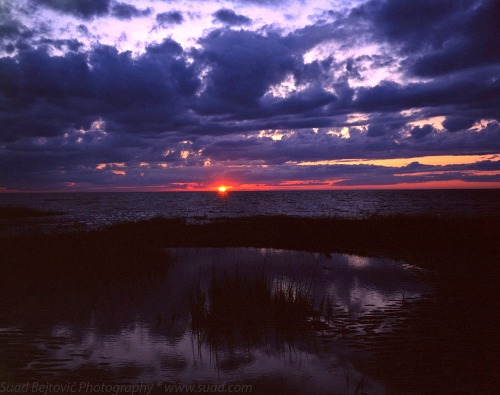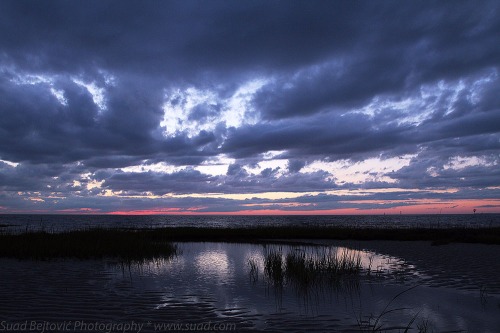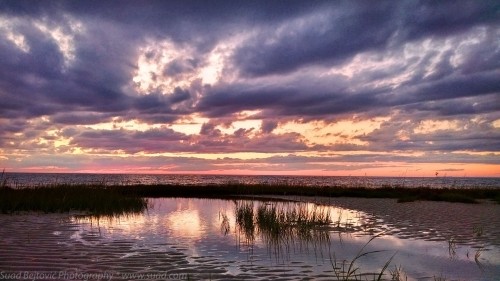This past summer, I had the opportunity to visit Cape Cod, Massachusetts for the first time. It’s a place of quiet fishing villages, trendy tourist destinations and hip hangouts. Since it’s a peninsula, it’s also a very convenient destination for both sunrise and sunset photography – on multiple days, I was able to shoot both golden hours.
In this post, I present three shots taken within moments of each other, with three different cameras. It was a sunset shoot at Rock Harbor, not far from the city of Orleans, MA. The extremely low tide left many tidal pools and exposed sand dunes and grass patches, so there were plenty of ways to experiment with composition.
First up is my massively reliable medium format camera, Mamiya 7, which was loaded with the legendary Fuji Velvia 50 film. The metering for a sunset scene is never easy, and for a contrasty film like Velvia, I wanted to preserve the highlights, but the shot still ended up quite underexposed — most of the foreground is just too dark. On the other hand, the setting sun and the sky at the horizon have a great color to it, and I love the dark fluffy clouds on top set against the still bright sky. The composition of the foreground is also pleasing, with the patch of grass in the tidal pool. As usual for a shot done on Velvia, I didn’t do much post-processing; I tried to improve the shadows a bit, but not to the point where the photo becomes too grainy.
A few moments later, the sun finally set, but the sky was still pretty bright. This shot was taken by my digital camera, Canon 7D, at the widest setting on my 17-40mm f/4L lens. The composition seems a little different, lower to the ground, and the horizon falls closer to the rule of thirds. The bluish tint is typical for the “blue hour”, but there is still some reddish hues to add interest to the shot. As in the film shot, the tidal pool provides a great reflection, and I like the ripples in the sand, too. I would have liked some more color in the photo, but it still has a nice moody quality – of the three shots, it would probably work the best in black and white. And speaking of quality, even at ISO 800, there is almost no noise or grain in the image.
Finally, we have the humble smartphone camera; I had with me the Droid Ultra and its 10 megapixel camera, which is more than decent. I metered for the brightest part of the image and let the automatic settings fall where they may. As it happens, I like this shot the best, and it’s partly because of the very wide native format of the camera, which works well with the scene. It’s also very bright, but nothing seems too blown out. There is some chrominance noise in the clouds, but other than that, the shot looks very sharp and clean. I posted it on my Instagram page in its cropped form.
In the end, no one shot is significantly better than the others, but this exercise helps me compare how different cameras see the same scene, so that I can use them more efficiently next time.


